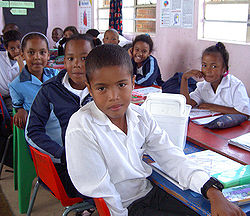BLACK SOCIAL HISTORY
Cape Coloureds
 Extended coloured family with roots in Cape Town, Kimberley and Pretoria. | |
| Regions with significant populations | |
|---|---|
| South Africa, Namibia, Zimbabwe | |
| Languages | |
| Afrikaans, Kaapse Afrikaans, South African English | |
| Religion | |
| Christian (80%), Muslim (5%)[1] | |
| Related ethnic groups | |
| Afrikaners, European, Khoikhoi, Xhosa, Cape Malay, Indian South Africans |
In Southern Africa Cape Coloureds is the name given to an ethnic group composed primarily of persons of mixed race. Although Cape Coloureds form a minority group within South Africa, they are the predominant population group in the Western Cape.
They are generally bilingual, though some speak only Afrikaans, and others primarily speak English. Some Cape Coloureds may "code switch",[citation needed] speaking a patois of Afrikaans and English called Kaapse Afrikaans. Cape Coloureds were defined under the apartheid regime as a subset of the larger Coloured race group.
At least one genetic study indicates that Cape Coloureds have an ancestry consisting of the following ethnic groups:[2]
- Khoisan: (32–43%)
- Bantu-speaking Africans: (20–36%)
- Ethnic groups in Europe: (21–28%)
- Asian peoples: (9–11%)
Origin and history
The Cape Coloureds are a heterogeneous South African ethnic group, with diverse ancestral links. Ancestry may include European settlers, indigenous Khoisan and Xhosa people, and slaves imported from the Dutch East Indies (or a combination of all).[3] People from India and the islands within the Indian Ocean region were also taken to the Cape and sold into slavery by the Dutch settlers. The Indian slaves were almost invariably given Christian names but their places of origin were indicated in the records of sales and other documents so that it is possible to get an idea of the ratio of slaves from different regions. These slaves were, however, dispersed and lost their Indian cultural identity over the course of time. Slaves of Malay and other ancestry were brought fromIndonesia, Malaysia, Madagascar, and Mozambique. This diverse assortment of people was subsequently classified as a single group under the Apartheid regime.[4][5]
Under Apartheid, under the Population Registration Act as amended, the term Cape Coloured referred to a subset of Coloured South Africans, with subjective criteria having been used by the bureaucracy to determine whether a person was a Cape Coloured, or belonged to one of a number of other related subgroups such as the "Cape Malays", or "Other Coloureds".[6][7]
Cape Coloureds in the media
A group of Cape Coloureds were interviewed in the documentary series Ross Kemp on Gangs. One of the gang members who participated in the interview mentioned that black South Africans have been the main beneficiaries of South African social promotion initiatives while the Cape Coloureds have been further marginalised.
The award-winning film I'm Not Black, I'm Coloured - Identity Crisis at the Cape of Good Hope (Monde World Films, 2009 USA release) is one of the first historical documentary films to explore the legacy of Apartheid through the viewpoint of the Cape Coloured community, including interviews with elders, Pastors, members of Parliament, students and everyday people struggling to find their identity in the new South Africa.[8]
Terminology[e
Although the term "coloured" is treated as a neutral description in Southern Africa, in the West it is regarded as a derogatory term. In the USA, the preferred usage is "person of color"; although it should be noted that this term tends to mean any "non-white person", as opposed to a mixed-race person, where the term "multiracial" is used.














































































































No comments:
Post a Comment